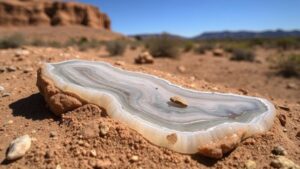Excavating ammonites with rainbow-like exteriors in Alberta’s Bearpaw Formation.
Excavating Ammonites with Rainbow-Like Exteriors in Alberta’s Bearpaw Formation
For rockhounds and mineral collectors, few treasures are as captivating as ammonites. Particularly, the stunning specimens found in Albertas Bearpaw Formation boast iridescent exteriors that shimmer in a spectrum of colors. This article delves into the unique characteristics of these fossilized creatures, the geology of the Bearpaw Formation, and practical advice for collectors eager to excavate these remarkable fossils.
Understanding Ammonites
Ammonites are marine mollusks that lived during the Mesozoic Era, notably from 240 to 66 million years ago. are known for their coiled shells, which were primarily composed of aragonite, a mineral form of calcium carbonate. The intricate suture patterns of ammonite shells can provide valuable information about the species and its habitat. The rainbow-like exteriors observed in some specimens are often caused by the presence of opalization – a process where the original shell material is replaced by silica in a way that reflects light in varying wavelengths.
The Bearpaw Formation
The Bearpaw Formation is a geological formation in Alberta that spans from the Late Cretaceous period, approximately 70 to 80 million years ago. It primarily consists of dark shale and represents a marine environment in which diverse marine life thrived.
- Geological Composition: The formation includes rich deposits of bentonitic clay and numerous fossilized remains of marine life, including ammonites, clams, and fish.
- Location: The Bearpaw Formation stretches across Alberta, with notable excavation sites near the town of Bassano and along the banks of the Bow River.
Excavation Techniques
Collecting ammonites in the Bearpaw Formation requires a combination of strategy, patience, and the right tools. Here are some effective techniques:
- Research Locations: Prior to heading out, its crucial to identify promising sites. Areas where erosion has exposed the shale are often the most fruitful.
- Use the Right Tools: Essential tools for excavating ammonites include a geological hammer, chisels, safety goggles, and a sturdy backpack for transporting your finds.
- Excavation Technique: When excavating, carefully chip away the rock surrounding the ammonite, taking care not to damage the specimen. This method is analogous to a sculptor revealing a statue from a block of marble – patience is key.
Identifying Quality Specimens
The value of ammonite specimens can vary significantly, contingent on factors such as size, preservation, and aesthetic appeal. Here are some characteristics to look for:
- Coloration: Rainbow-colored exteriors are more desirable among collectors, as they evoke a sense of rarity.
- Completeness: A fully intact specimen is more valuable than one that is fragmented.
- Size: Larger ammonites often command higher prices in the collectors market.
Real-World Applications for Collectors
For avid collectors and enthusiasts, excavating ammonites can be a rewarding endeavor. Beyond personal enjoyment, high-quality specimens can appreciate in value over time. demand for ammonites has grown in recent years due to their unique appearances and educational significance, making them an attractive investment.
Practical Tips for Collectors
As you embark on your journey to discover ammonites in Alberta, consider these actionable takeaways:
- Join Local Clubs: Collaborative efforts with local rockhounding clubs can provide invaluable resources and guidance on excavation techniques and best practices.
- Respect the Environment: Always follow land access rules and ethical collecting practices to ensure continued access to these rich geological sites.
- Document Findings: Keep a field notebook detailing your collection journey, including locations, conditions, and observations, to enhance your overall experience and knowledge.
Conclusion
Excavating ammonites with rainbow exteriors in Alberta’s Bearpaw Formation offers a fascinating glimpse into the regions geological and paleontological history. By understanding the characteristics of these fossils, employing effective excavation techniques, and fostering engagement with the rockhounding community, collectors can enhance their treasure-hunting experiences while contributing to the preservation of geological heritage.


